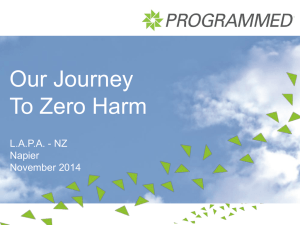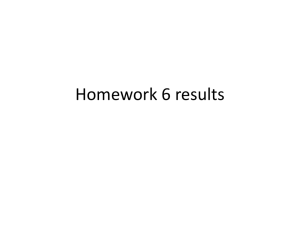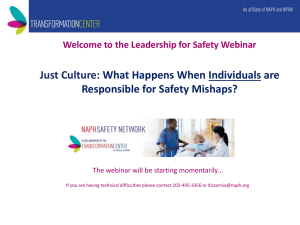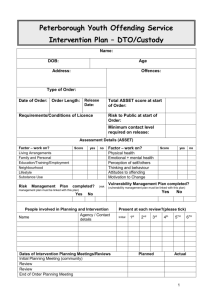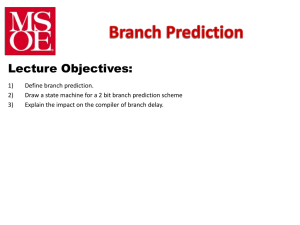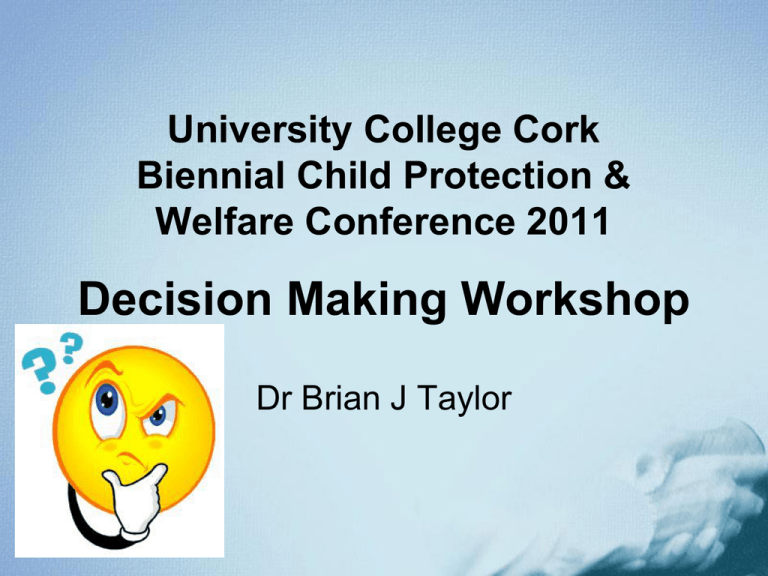
University College Cork
Biennial Child Protection &
Welfare Conference 2011
Decision Making Workshop
Dr Brian J Taylor
Contents
•
•
•
•
•
•
Assessment in decision making
Predicting child homicide & abuse
Use of risk factors in decision making
Are we achieving anything?!
Coordinated & specialist assessment
Models to support analysis in
assessment & decision making
2
Assessment & Decisions
• “… the aim of assessment is to
gather and order information for
analysis so as to inform professional
judgement and decision processes
about care [and protection].”
Taylor BJ (2010) Professional Decision Making
in Social Work, Exeter: Learning Matters
Post Qualifying Social Work Series [p.110]
3
Decisions and Assessment
• 4.1 factors that contributed to failure:
– ineffective assessment processes
– faulty decision making
• 4.4.1 A notable feature throughout the ...
period under examination is the absence
of any formal assessment of this case,
particularly in relation to risk to the
children.
Gibbons N (chairperson) (2010) Roscommon Child
Care Case: Report of the Inquiry Team to the Health
Service Executive (27 October 2010), Dublin: HSE
BUT what sort of assessment?
4
Some purposes of SW assessment
1.
2.
3.
4.
5.
Appraise risk of specific harms
Support analysis of information gathered
Engage child & family in problem solving
Decide on intervention
Decide on eligibility for services
FOR SOME OTHER PURPOSES SEE:
Taylor BJ (2010) Professional Decision Making in
Social Work, Exeter: Learning Matters [ch. 8]
5
Prediction in SW Assessment
• We want to predict harm so as to
focus scarce resources on those
most likely to come to harm
• Particularly we want to predict the
most serious (& less frequent)
harms
• BUT predicting rare events is
particularly problematic …
6
Intuitive (Clinical) Prediction
• My own life experience as a child?
• My own life experience as an adult?
• Relevant similar cases in my working
life?
• My understanding of research (?!)
• My understanding of theories (e.g.
stigma, attachment, bonding, loss &
bereavement) & their relevance?
7
Clinical Prediction & Bias
• Limited life & work experience
• Feedback on success with clients &
families is generally limited
• My perceptions may be influenced by
vivid or more recent events, workload
pressures, personal crises etc …
• My judgements may be unduly
influenced by the media, peers,
political pressure …
8
Informed by Evidence?
• IF we knew how often the undesirable
event occurred in the past
• AND the relevant characteristics of the
situations where it occurred
• THEN we could use that knowledge to
predict how often the event might
occur in the future
• = actuarial prediction
• used by insurance companies
9
Knowledge of Risk Factors
• Re-offending by serious
offenders
• Homicide by people with
mental health problems
• Suicide
• Admission to long-term
nursing home care
• Child abuse & neglect
10
Suicide risk factors (England & Wales)
(Gunnell, 1994)
< 4 wks after disch. from psych hospital, male *200
< 4 wks after disch. from psych hospital, fem *100
alcohol abuse or drug misuse
*20
current or ex-psychiatric patient
*10
prisoner
*5
doctor
*2
farmer
*2
unemployed
*2
HOW DO WE USE THIS SORT OF KNOWLEDGE?
11
Example of A Scoring Tool
•
•
•
•
•
•
•
•
Age Less than 25
Victim gender Any male
Relationship to victim Any non-related
Past sex offences
0
1 conviction OR 1 to 2 charges
2 to 3 convictions OR 3 to 5 charges
4+ convictions OR 6+ charges
1
1
1
0
1
2
3
Thornton D (2007) ‘Risk Matrix 2000 (Revised):
Assessment and Management of Sex Offenders’,
Probation Circular PC17/2007, 1 July
12
Recidivism & predictive validity
Score
No (%) in group
at 5 yrs
at 10 yrs
0
1
2
3
4
5
527 (20%)
806 (31%)
742 (29%)
326 (13%)
139 (5%)
52 (2%)
4%
8%
14%
25%
33%
50%
7%
11%
21%
37%
49%
73%
13%
20%
• Total
2592
13
Predictive assessment: 4 possibilities
1.correctly predict the harm -true positive
2.indicate that harm will not occur, but it
does -false negative
3.correctly predict that harm will not
occur -true negative
4.indicate that harm will occur, but it does
not -false positive
14
Suicide Prediction
• 2006 NI: 227 male & 64 female
• 300 in population of 1.5 million
• i.e. 2 in 10,000
• Could we use a screening
(assessment) tool with 90%
accuracy to identify these
people so as to target
services?
15
TOOL:
Yes
REALITY: harm
No harm
Total
Yes harm 270
30
300
No harm
149,970 1,349,730 1,499,700
Total
150,240 1,349,760 1,500,000
16
Issues in using risk factors
• False positives = a child taken wrongly
from a family [happens anyway?!]
• Labelling if there is an issue of stigma
• Human rights
• LIMIT: Better prediction for the original
population = less generalisable to others
• We can do nothing about static factors;
need to focus on dynamic risk factors
17
Actuarial vs Intuitive Prediction
• Most of the research shows that (actuarial)
prediction using risk factors is more
accurate than (intuitive) professional
‘clinical’ prediction
• When the base rate (incidence) is low any
prediction has poor accuracy
• The causal routes to extreme harm are
varied, so even good (simple) use of risk
factors (as by insurance companies) is
difficult
18
Expected to use risk factors?
• Inquiry reports seem to assume that
risk factors will be taken into
account by professionals in
safeguarding roles
• In social work we need to learn to
understand & use this type of data
so as to make better informed
decisions
• Decision model 1
19
Prospects for Risk Factors
• screening from a sub-population (eg
those referred) is more accurate than
predicting from the general population
• Predicting RE-abuse or RE-offending
from amongst previous abusers or
offenders is likely to be more accurate
than predicting first time events
• USE risk factors to INFORM current
modes of unaided professional
judgment
20
Predicting harm to individual
children in social work is like
expecting an insurance company
to predict precisely WHICH
young drivers will have an
accident!
21
Are we achieving anything in
terms of protecting children?!
•
•
•
•
•
•
Death as the “sharp end” of abuse
World Health Organisation data
Use 3 year averages as small figures
1980 = average of 1979, 1980 and 1981
2005 = average of 2004, 2005 and 2006
International Classification of Diseases
ICD-10 cause of death definitions:
http://apps.who.int/classifications/icd10/browse/2010/en
22
Violent Possible ‘Child Abuse
Related Deaths’ = Homicide + Other
External Causes of Death +
Accidents & Adverse Events (rate
per million, age U 14)
• rpm
1980
2005
%change
• RoI
209
30
-86
• UK
183
54
-70
NB death through Ill Defined Signs and Symptoms
may include some Sudden Infant Death
Syndrome, but these are NOT included here
23
Nos Child (U14) Deaths 1980 vs 2005
•
•
•
•
•
•
•
Rep Ireland 1980
All Causes 1217
Homicide
03
OECD
00
AAE
177
IDSS
127
poss ‘CARD’ 307
2005
330
01
01
24
32
58
%change
-73%
-67%
+100%
- 86%
-75%
-81%
24
Improving assessment &
decision making
5.3.2 It is recommended that: A national
common assessment framework be
introduced without delay for all child
welfare and protection cases. The
framework needs to identify core
components while allowing for
flexibility.
Gibbons N (chairperson) (2010) Roscommon Child
Care Case: Report of the Inquiry Team to the Health
Service Executive (27 October 2010), Dublin: HSE
25
Integrated Assessment: Aims
• E.g. CAF (England & Wales), UNOCINI (NI),
GIRFEC (Scotland)
• Assessment proportionate to need
• Gather information once
• Capture all relevant perspectives
• Structure information from multiple sources
• Simplify access to information
• Promote integrated professional working
• Standardise data gathered for service
development
26
Holistic, integrative assessment
•
•
•
•
•
•
•
Provide a holistic overview
Ensure comprehensive breadth
Avoid missing the ‘obvious’
Reduce burden by reducing duplication
Enable multi-professional working, inc:
Synthesise specialist assessments
Support consistent decision making
27
Holistic & Specialist Assessment
• Social Workers are normally given the
role of coordinating assessment
across professionals & organisations
• BUT we also need to contribute
specialist social work assessment
28
Specialist Social Work Assessment
• Family functioning: eg genograms
• Engaging parents re neglect: eg GRADED
Care Profile
• Support for parents: eg Arizona Social
Support Scale
• Parenting & environment: eg HOME scale
• Risk of re-offending: eg Matrix 2000
• Domestic Violence: eg Maddie Bell Tool
29
Munro E (2010) Munro Review of Child Protection
- Part One: A Systems Analysis, London:
Department for Education
• Beware of exclusive focus on technical
solutions – increasing rules, more detailed
procedures, more use of ICT
• We need:
– skills to engage with families
– expertise to bring about enduring
improvements in parenting behaviour
– support that enables [us] to manage
emotional dimensions of the work without it
harming judgment or own well-being
30
Assessment Tools should support:
• Effective engagement of clients &
families in discussing risks, values,
facts, knowledge
• Gathering & ordering of appropriate
client & family data
• Analysis of this data to aid:
• Decisions in uncertainty regarding
possible services or statutory
interventions
31
Analysis in Assessment
• Most tools are good at:
– Ensuring suitable data gathering
– Helping to order data
– Supporting communication across
professions & organisations
• Most of our tools are poor at:
– supporting analysis of the data gathered
ie relating client data to theory about
families, research on what works, etc
32
Models of
Decision
Making
to aid analysis of
assessment information
Model 2 Image Theory for Client
Decision Making
- sequenced stages, used only as required
1 fundamental values
2 life goals
3 tactics to achieve my aims
e.g. engaging with a case conference
Consider Social Work role in this
Lee Roy Beach & Terry Connolly (1997) The
Psychology of Decision Making: People in
Organisations California: Sage
34
Model 3 Balancing Benefits and
Harms for Care Planning Decisions
1. Clarify options
2. Give a Value for
each outcome
3. IF UNCERTAIN:
Clarify Likelihood
of each option
4. Value x Likelihood
5. Weigh up
= SUBJECTIVE EXPECTED UTILITY
35
Weighing up options for a child
leaving state care:
- Value V * Likelihood L = Total T
- Support:
V=6
L = 0.7
T = 4.2
- Likely to be led astray:
V = -8
L = 0.3
T = -2.4
Total = 1.8
Value scores -10 to +10 in this example
Can develop into a decision tree
36
Model 4: Fuzzy Prediction
• Brearley Model (fuzzy set theory)
• Conceptualise risk factors without
quantifying them
• Vulnerabilities (predisposing factors)
• Triggers (precipitating factors)
• Strengths & Mitigating factors
Paul Brearley (1982) Risk in Social Work
London: Routledge & Kegan Paul
37
Model 5: Use a Decision Process
1. Clarifying decision context
2. Involving the client
3. Meeting with stakeholders
4. Thinking and feeling about the decision
5. Framing the decision situation
6. Choosing an option
7. Evaluating the decision
Terence O’Sullivan (1999) Decision Making in
Social Work Basingstoke, Hampshire:
Macmillan
38
Model 6: Threshold Decisions
• Protection or eligibility for services
• Consider situation against a threshold
• Model 6A: Satisficing Model
– IF limited time or information
– SELECT the first option found that is
‘good enough’
• eg placement during out-of-hours
Herbert Simon (1956) Rational choice and the
structure of environments, Psychological Review,
63, 129-138
39
Model 6B: Bounded Rationality
Extends & generalises Satisficing Model
• RULE 1: How to search for information
• RULE 2: When to stop searching
• RULE 3: A simple rule for choosing an
option
Gerd Gigerenzer & Richard Selten (2002)
Bounded Rationality: The Adaptive Toolbox,
Cambridge, MA: MIT Press
40
FOR MORE on this topic
Decisions, Assessment, Risk
and Evidence in Social Work
Conference: 02 & 03 July 2012
organised by University of Ulster
Email: dare@ulster.ac.uk
www.socsci.ulster.ac.uk/irss/dare2012
Templepatrick nr Belfast International
Airport
41
University College Cork
Child Welfare Conference 2011
Decision Making Workshop
THE END
Dr Brian J Taylor





